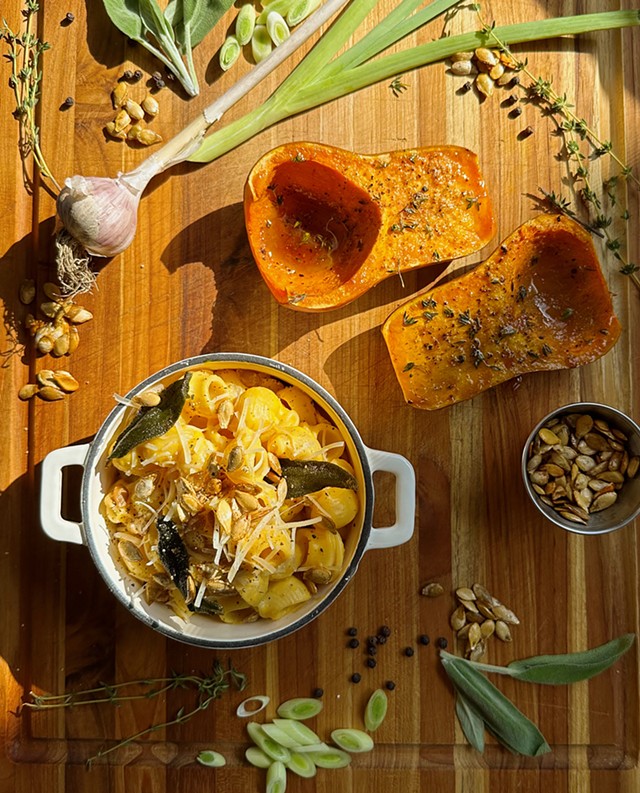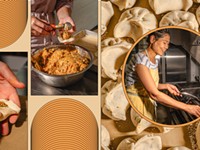[
{
"name": "500x250 Ad",
"insertPoint": "5",
"component": "15667920",
"parentWrapperClass": "",
"requiredCountToDisplay": "1"
}
]
In 2022, I left my job in a neuroscience lab to follow my dream of becoming a chef. And as a newly inducted line cook, I’ve been granted a glimpse into the minds of the chefs that make up Rochester’s vibrant restaurant industry. There are two fundamental ideals that I have adopted while working within the ‘back of house’ and extended to my culinary endeavors at home: cook with the seasons and use the entirety of your produce.
Thinking like a chef means appreciating — cherishing, even — those few weeks in June where everyone calls their garlic scapes dealer, the late summer sweetness of hand-picked tomatoes, and the bittersweet knowledge that the first morning you scrape ice off your windshield, you should have winter squash for dinner. Thinking like a chef also means repurposing the ‘scraps’ that would often be thrown away in a home kitchen: scallion butts, the pulp from a juiced pineapple, seeds from a pumpkin — these all play a role in the orchestra that is back of house.
Chlovia Loomis, manager at Growing Family Farms, is a local advocate for seasonality and no-waste creativity, her seasonal crops last throughout November (spoiler: they have the cutest squash variety ever, the honeynut).
Loomis has been managing Growing Family Farms, a small operation in Spencerport, for the last three years, and working on the grounds for the last 11 years. GFF utilizes regenerative farming, minimal transportation efforts, and does not introduce synthetic pesticides and fertilizers to their crops. On a certified organic farm, Chlovia explained there is ‘nowhere to hide.’ Every seed is documented from sow, tray location, and harvest — all the way to the date and location sold. When you buy from a certified organic farm, you are supporting thorough, intentional and environmentally conscious farming practices.
While the farm slows down for the ‘shoulder season’ (between peak and off-season), crops seeded in September will be ready for harvest and enjoyment in November. Hearty ‘storage crops’ such as carrots, cabbage, winter squash, garlic, onions and leeks are available in November, as well as the more glamorous (borderline dramatic) leafy greens that sprawl out in their indoor greenhouse beds throughout the winter. Loomis’s excitement surrounding her honeynut squash this November was contagious; a hybrid of butternut and buttercup squash, honeynut has a sweet, nutty flavor that pairs well with said ‘storage crops,’ specifically garlic, leeks, and hearty fall herbs.
The cool, crisp air of shoulder season conjures dreams of warm, comforting flavors, and Anto Yockel, a chef at Vern’s on Park Avenue, gave additional guidance for elevating the honeynut into a restaurant-worthy dish. He shared a technique to extract all the squash flavor possible into a sauce: roast, soak in herby milk, and purée to smooth perfection. Then, toss the sauce with pasta, fold into a risotto, or use as a base for pizza, it’s as versatile as it is delicious. Yockel shares Loomis’s commitment to no-waste cooking, so he also suggested simmering the peeled honeynut skins in a vegetable broth, roasting and seasoning the seeds, and even peeling and pickling the lighter-colored squash ribbons just below the peel.
Below is Yockel’s full recipe.
Honeynut Squash Cream Sauce
Makes 2 cups, or 6-8 servings of sauced pasta. Keeps 7 days if refrigerated. Freezer safe in an air-tight container.
Ingredients:
3 tablespoons unsalted butter, cubed
1 baby honeynut squash (or .5 lb any squash variety)
1 leek, chopped
8 sprigs thyme
5 leaves sage
1 teaspoon ground nutmeg
1 tablespoon dark brown sugar
1 garlic clove, minced
¾ cup whole milk
Salt & pepper, to taste
1. Preheat the oven to 350F and line a large baking sheet with parchment paper. Cut squash in half, then peel, and deseed. (Clean and roast seeds with salt and olive oil and/or save the peels for a stock, if desired.)
2. Drizzle squash with olive oil, thyme, nutmeg, brown sugar, salt and pepper. Roast squash for 25 minutes, until fork tender.
3. Chop leek into ½ inch discs. While squash roasts, heat olive oil and minced garlic in a small pan. When oil is glimmering, add the leeks and saute until softened. Add sage leaves to the pan, removing from heat once sizzled and crisp. Remove the leeks and sage, but save the infused oil and garlic.
4. Add milk, thyme, butter, and the infused oil from the pan to a saucepan. Add the roasted squash and cook over medium-low heat, bringing to a simmer. Let simmer for 10 minutes, stirring gently.
5. Blend the squash and milk mixture until smooth. Season with salt to taste. Pour over pasta and thin with a small ladle of pasta water until glossy. Top with parmesan, crispy pumpkin seeds, sizzled sage, sauteed leeks, and black pepper. Enjoy warm.
Natasha Cotrupi is a contributor to CITY. Feedback about this article can be directed to [email protected].
Thinking like a chef means appreciating — cherishing, even — those few weeks in June where everyone calls their garlic scapes dealer, the late summer sweetness of hand-picked tomatoes, and the bittersweet knowledge that the first morning you scrape ice off your windshield, you should have winter squash for dinner. Thinking like a chef also means repurposing the ‘scraps’ that would often be thrown away in a home kitchen: scallion butts, the pulp from a juiced pineapple, seeds from a pumpkin — these all play a role in the orchestra that is back of house.
Chlovia Loomis, manager at Growing Family Farms, is a local advocate for seasonality and no-waste creativity, her seasonal crops last throughout November (spoiler: they have the cutest squash variety ever, the honeynut).
Loomis has been managing Growing Family Farms, a small operation in Spencerport, for the last three years, and working on the grounds for the last 11 years. GFF utilizes regenerative farming, minimal transportation efforts, and does not introduce synthetic pesticides and fertilizers to their crops. On a certified organic farm, Chlovia explained there is ‘nowhere to hide.’ Every seed is documented from sow, tray location, and harvest — all the way to the date and location sold. When you buy from a certified organic farm, you are supporting thorough, intentional and environmentally conscious farming practices.
While the farm slows down for the ‘shoulder season’ (between peak and off-season), crops seeded in September will be ready for harvest and enjoyment in November. Hearty ‘storage crops’ such as carrots, cabbage, winter squash, garlic, onions and leeks are available in November, as well as the more glamorous (borderline dramatic) leafy greens that sprawl out in their indoor greenhouse beds throughout the winter. Loomis’s excitement surrounding her honeynut squash this November was contagious; a hybrid of butternut and buttercup squash, honeynut has a sweet, nutty flavor that pairs well with said ‘storage crops,’ specifically garlic, leeks, and hearty fall herbs.
The cool, crisp air of shoulder season conjures dreams of warm, comforting flavors, and Anto Yockel, a chef at Vern’s on Park Avenue, gave additional guidance for elevating the honeynut into a restaurant-worthy dish. He shared a technique to extract all the squash flavor possible into a sauce: roast, soak in herby milk, and purée to smooth perfection. Then, toss the sauce with pasta, fold into a risotto, or use as a base for pizza, it’s as versatile as it is delicious. Yockel shares Loomis’s commitment to no-waste cooking, so he also suggested simmering the peeled honeynut skins in a vegetable broth, roasting and seasoning the seeds, and even peeling and pickling the lighter-colored squash ribbons just below the peel.
Below is Yockel’s full recipe.
Honeynut Squash Cream Sauce
Makes 2 cups, or 6-8 servings of sauced pasta. Keeps 7 days if refrigerated. Freezer safe in an air-tight container.
Ingredients:
3 tablespoons unsalted butter, cubed
1 baby honeynut squash (or .5 lb any squash variety)
1 leek, chopped
8 sprigs thyme
5 leaves sage
1 teaspoon ground nutmeg
1 tablespoon dark brown sugar
1 garlic clove, minced
¾ cup whole milk
Salt & pepper, to taste
1. Preheat the oven to 350F and line a large baking sheet with parchment paper. Cut squash in half, then peel, and deseed. (Clean and roast seeds with salt and olive oil and/or save the peels for a stock, if desired.)
2. Drizzle squash with olive oil, thyme, nutmeg, brown sugar, salt and pepper. Roast squash for 25 minutes, until fork tender.
3. Chop leek into ½ inch discs. While squash roasts, heat olive oil and minced garlic in a small pan. When oil is glimmering, add the leeks and saute until softened. Add sage leaves to the pan, removing from heat once sizzled and crisp. Remove the leeks and sage, but save the infused oil and garlic.
4. Add milk, thyme, butter, and the infused oil from the pan to a saucepan. Add the roasted squash and cook over medium-low heat, bringing to a simmer. Let simmer for 10 minutes, stirring gently.
5. Blend the squash and milk mixture until smooth. Season with salt to taste. Pour over pasta and thin with a small ladle of pasta water until glossy. Top with parmesan, crispy pumpkin seeds, sizzled sage, sauteed leeks, and black pepper. Enjoy warm.
Natasha Cotrupi is a contributor to CITY. Feedback about this article can be directed to [email protected].






